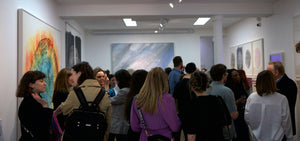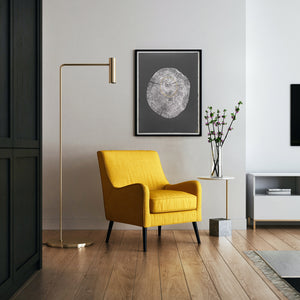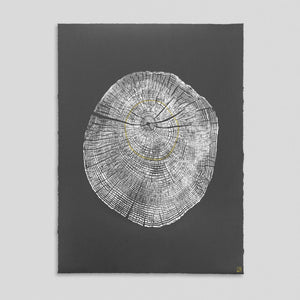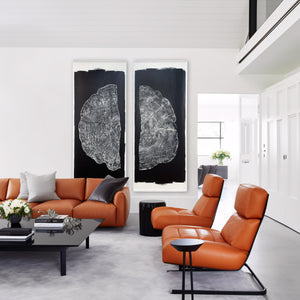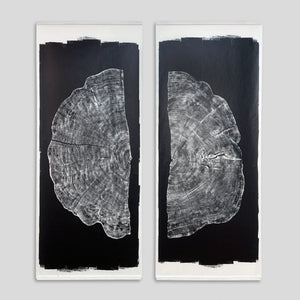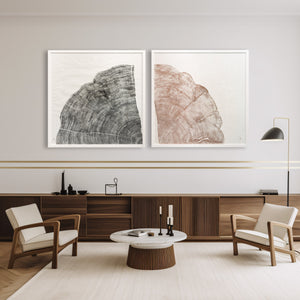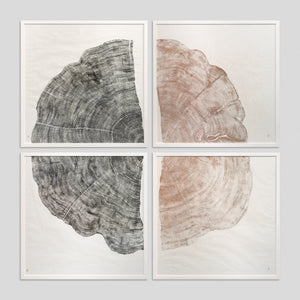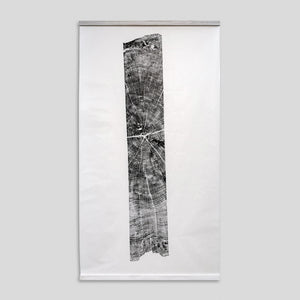"Struck" - My inaugural exhibition
Jun 06, 2023
As an artist, and in my role as the Founder and Global Creative Director of Pearlfisher, I've always been drawn to the intersection of creativity, design, and the natural world. My work in both domains challenges me to look at our surroundings from different perspectives and to question how our actions impact the world we live in.
This is why my inaugural exhibition, "Struck", is a particularly significant endeavour for me. It represents not just the culmination of my recent work but a profound personal journey and an experiment that merges my various passions and concerns; as such I would like to share my speech from the opening night:
Good evening. It’s great to welcome you all here, and to see so many familiar faces. For those of you, who for any reason don’t know me, I am the Founder and Global Creative Director of Pearlfisher; and, now, the artist behind Struck.
This is a new focus and experiment for me. As I am always telling my talented team, a good creative always pushes themselves and should never stop regardless of position or seniority; and this is where I am with this exhibition.
Like the tree at its centre, the idea for Struck has been slowly growing over the years. But suddenly everything aligned: my passion for garden design, a desire to return to slow, handcrafted design processes and a chance encounter with the woodsman who reclaimed this colossal trunk after it was struck by lightning.
This is indeed a magnificent tree with a magnificent history. It was planted in the 1800’s on the Rushmore Estate in Wiltshire, by the famous English Army Officer, archaeologist and ethnologist, Lieutenant General Augustus Pitt Rivers.
By telling the unique story of this tree through this artwork, I want to make people stop and think about the impact of design and creativity on our future story: a story for you, your brand and the world around us.
We often overlook or exploit nature and its inherent creativity. But, by looking at tree rings in a new way we can not just see where we've been, but where we are now heading.
Three of the canvases on display depict major changes in our global climate within my lifetime:
“Cut” and “Rainforest Gold” show how half of the world's rainforests have been destroyed in just one century.
“Flare” loosely shows how the world has heated up significantly since the Second World War and the rise of consumerism; and, since this tree died how global temperatures continue to rise and cause related change.
“Melt" highlights the prediction that we will lose at least a 3rd of world glaciers by the end of this century.
But this show is not about spreading doom and gloom. It’s about using creativity, the scale of this tree and its revealed natural beauty to get a message across; a message that can speak to different people in different ways.
For me personally, it speaks of the significance of process in time, nature, place, humanity; and, now, in creativity. And this is what I want to talk a little more about.
First off, the process to produce this body of work was in no way easy. In fact, it was sheer, relentless, often scary hard work with a high risk and high failure rate, and all about endless trial and error… actually, just as it should be. The process of creativity should never ever be easy or formulaic.
Nearly all of you here will have experience, in one form or another, of a branding project. Typically there are 4 stages: Strategy, Design, Development and Realisation.
The creative exploration and ideas phase, within in the Design stage, is often only tiny; it can be as little as 10% of the overall project time but it is still scrutinised and evaluated to the ‘nth degree’.
As with these prints though, any worthwhile creative process is time consuming. It should be; it should never be shortened. The process as much as the outcome must be celebrated.
Ultimately, to produce human-centric designs, ones that better our lives and progress our society, you need human interaction and design thinking; you need the process that comes with it, the mistakes and errors to make things crafted
We have all become (often unwittingly) caught up in the new process of instafication; being made so much more aware of what tech, and particularly AI, is capable of producing. And, yes, in many ways it’s seamless and accessible to everyone. And, yes, I have also questioned whether it can really do my job; and no, it can’t.
We need to create a vision for the future we want to live in. Tech and machines can be an evolving and influential part of the creative process but vision and ideas are not created by tech and machines. They never should or will replace humans.
The commissioning of creativity, and building a relationship between ‘client and creative’ is in itself an integral and important part of this process. You only have to look back through history; from the Pope commissioning Michelangelo to create frescoes for the Sistine Chapel, to the modern day and how evolving creative works have been commissioned for the Fourth Plinth.
At Pearlfisher, we’ve very lucky that we have visionary clients, some here tonight, who appreciate both the process of commissioning and the time needed to achieve that original idea that makes a stand-out difference to the brand, its market and its audience; but which also stands the test of time.
For brands, like this tree, it’s about what lies beneath the surface, the layers that make it stronger over time, the totality of everything coming together from its roots. This makes it both recognisable and desirable. We feel its life, its energy, its potential branching out; and we want to be part of it.
Ultimately, the creative process is about layering and connecting everything and everyone to find the most impactful solution. Which brings us full circle back to this tree struck by lightning.
Although this may be the end of this particular tree, I am hopefully giving it a second life and also hopefully giving the people who interact with it something to think about and act on.
Maybe, it’s the fact that there is no waste in nature and we should be emulating this; striving for a truly circular and waste-free economy. Maybe, as with my ‘Jenga’ print, it’s the idea that building a business on foundations that won’t be able to sustain exponential growth, and, with finite resources, will lead to its inevitable collapse.
We need to think about the legacies we are leaving through the world we are building. We are all part of this bigger process. Creativity is no longer a nice to have but a need to have. It should be the most coveted and defining skill of the future: integral to our critical thinking, problem-solving and survival; on all levels.
To build a better society; and the most successful ventures, businesses and brands within it; creativity must now be seen as an essential partner and work hand-in-hand with sustainability and economic strategies to build a healthier world; which is entirely possible if we put our minds to it.
Looking back, the experience of creating and presenting "Struck" was not only about the beautiful pieces I had the privilege to work on, or the audience reactions, but it was a profound reminder of the role and responsibility that we as creatives have. The way we express our ideas, use our resources, and think about the consequences of our work can make a difference in the world.
In creating the pieces for "Struck", I explored some of the most pressing issues of our time – deforestation, climate change, the melting of polar ice caps. The tree at the center of this exhibition bore silent witness to these changes over decades, and through my work, I sought to give it a voice. But this isn't where the story ends. It's not enough to create art that simply makes us aware of these problems; it's about sparking conversations and prompting action.
In many ways, "Struck" is a beginning, an invitation to a deeper conversation about our relationship with the natural world, about how we design our future and the legacies we leave behind. I hope this work and these themes will continue to resonate and inspire action long after the exhibition itself has ended.
Whether we're shaping brands at Pearlfisher or creating a piece of art, the heart of our work is storytelling. And as I continue this journey, I look forward to discovering new stories, fostering new dialogues, and harnessing the power of creativity to make a meaningful difference. I'm immensely grateful to everyone who has supported this journey so far, and I can't wait to see where we go from here.
Remember, each of us has a role to play, a unique contribution to make. Let's continue to push ourselves, ask difficult questions, and strive for a better, healthier world.

